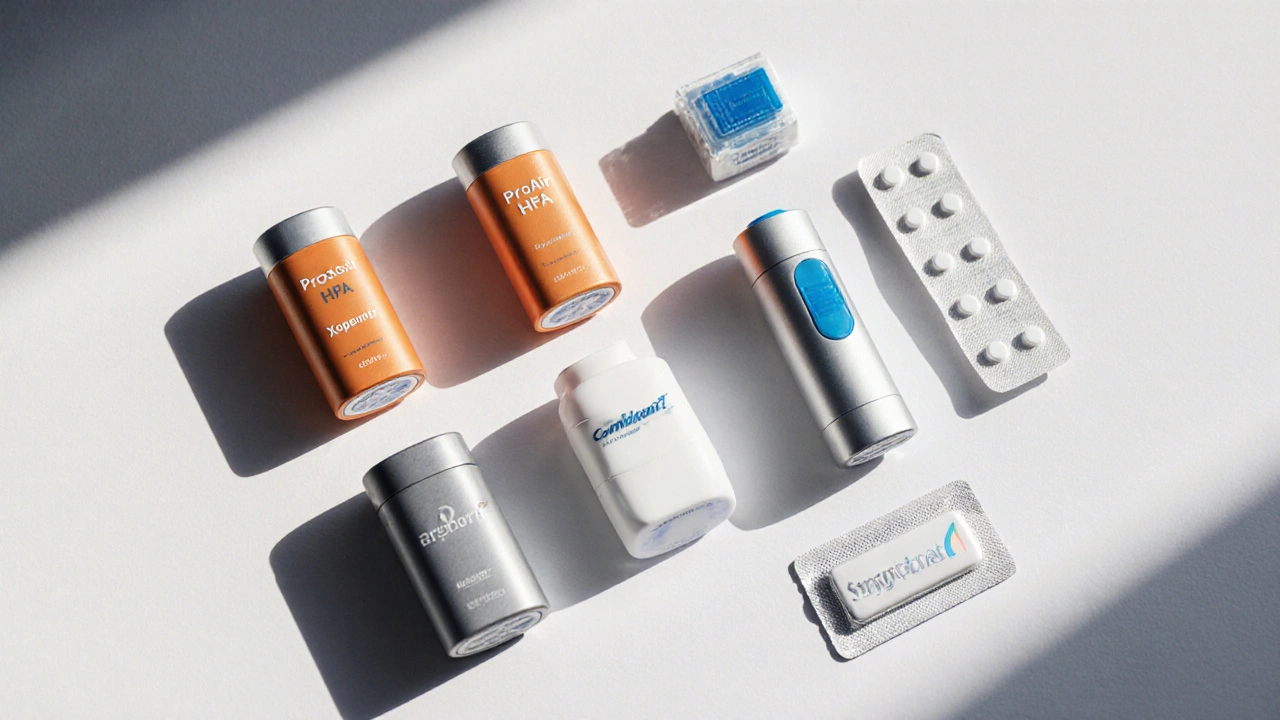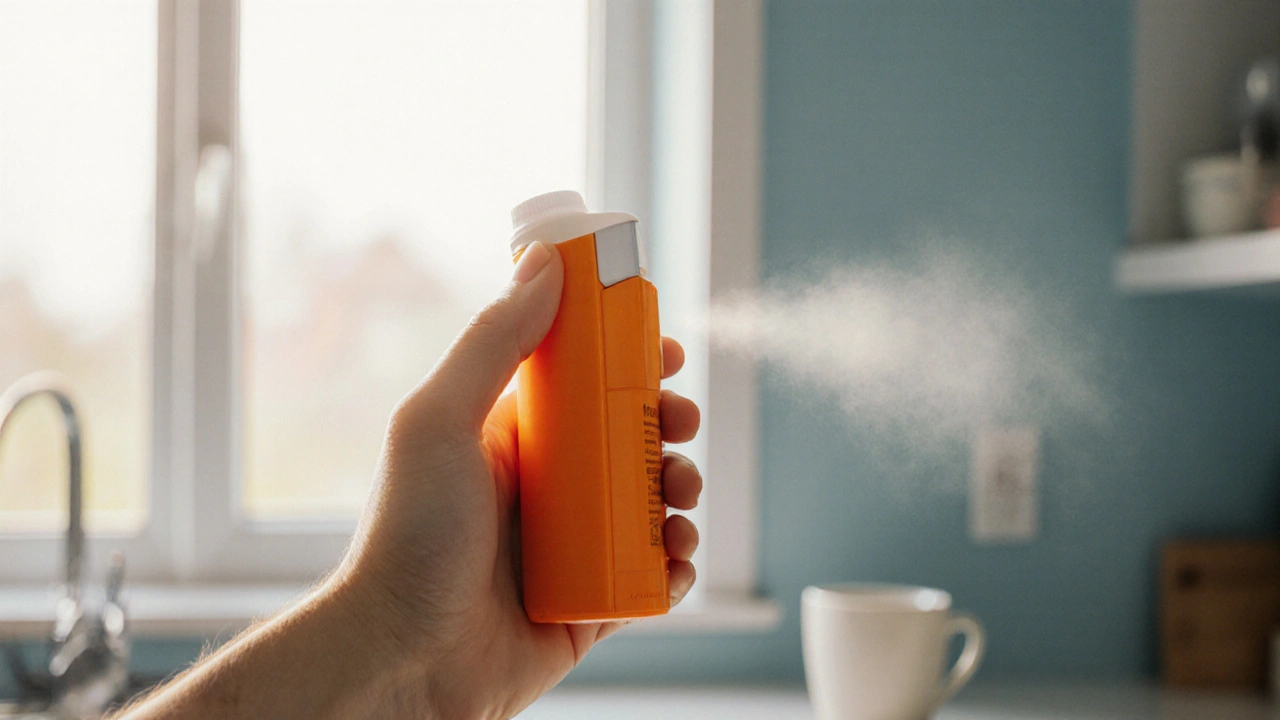Ventolin vs Alternatives: Inhaler Comparison Tool
Inhaler Details
Active Ingredient: Albuterol
Device Type: MDI
Onset Time: 5-10 minutes
Duration: 4-6 hours
Typical Dose: 1-2 puffs PRN
Prescription Required: Yes
Common Side Effects: Throat irritation, tremor
Comparison Summary
Compare different inhalers based on your priority. Select an inhaler and a priority above to see how it performs against others.
When you reach for an asthma inhaler, Ventolin (generic name Albuterol) is often the first name that comes to mind. Ventolin is a short‑acting β2‑agonist (SABA) inhaler that quickly relaxes airway muscles to ease breathing during an attack. But dozens of other options exist, and not every inhaler works the same way for every person. This guide breaks down the most common alternatives, so you can decide whether a Ventolin alternative fits your lifestyle, symptoms, or doctor’s advice.
Quick Take
- Ventolin (Albuterol) works within 5‑10 minutes and lasts about 4‑6 hours.
- ProAir HFA and Proventil HFA have similar speed but differ in device feel.
- Levalbuterol (Xopenex) may cause fewer heart‑related side effects.
- Long‑acting combos like Symbicort add control for daily symptoms.
- Choosing the right inhaler depends on onset, duration, cost, and personal preference.
How Ventolin Works and Who It Helps
Ventolin belongs to the SABA class, which means it provides fast relief by binding to β2 receptors in the bronchial smooth muscle. This binding triggers a cascade that relaxes the muscle, opening the airway within minutes. It’s meant for sudden wheezing, exercise‑induced bronchoconstriction, or as a backup to a daily preventive plan.
Typical dosing for adults is 1-2 puffs every 4-6hours as needed, up to a maximum of 8 puffs per day. Children 4-11years usually get 1-2 puffs every 4-6hours, not exceeding 6 puffs daily. Because it acts quickly, it’s the go‑to rescue inhaler in most asthma action plans.
Key Alternatives to Ventolin
Below are the most widely prescribed SABAs and a few combination products that people often consider instead of Ventolin.
ProAir HFA (generic Albuterol) uses the same active ingredient as Ventolin but delivers it through a different metered‑dose inhaler (MDI) design. Some users find the smaller canister easier to carry.
Proventil HFA also contains Albuterol. Its inhaler feels similar to a traditional asthma puff, and it’s often stocked in pharmacies under the generic label “Albuterol HFA.”
Xopenex (generic Levalbuterol) is a racemic‑free version of Albuterol. Clinical trials in 2022 showed it produced comparable bronchodilation with a 15% lower incidence of tremor and palpitations.
Combivent pairs Albuterol with Ipratropium, an anticholinergic. It’s handy for patients who need both rapid relief and a mild long‑acting effect, especially in COPD‑overlap cases.
Symbicort (generic Budesonide/Formoterol) combines an inhaled corticosteroid (ICS) with a long‑acting β2‑agonist (LABA) that starts working in about 1-2minutes. It’s prescribed for people who want both rescue and control in one device.
Singulair (generic Montelukast) isn’t an inhaler-it’s an oral tablet that blocks leukotrienes, a different pathway that causes airway inflammation. Some patients use it alongside a SABA like Ventolin to reduce overall flare‑ups.

Side‑Effect Profile: What to Watch For
All SABAs share a core set of possible side effects: jittery feelings, rapid heartbeat, and a dry mouth. The intensity varies by individual and by formulation.
- Ventolin/ProAir/Proventil: Most common complaints are throat irritation and a mild tremor.
- Levalbuterol (Xopenex): Studies suggest up to 20% fewer cardiac side effects, making it a good option for patients with heart‑rate concerns.
- Combivent: Adding Ipratropium can cause a bitter taste and occasional dry eyes, but it often reduces the need for a second inhaler.
- Symbicort: Because it contains an corticosteroid, long‑term use can lead to oral thrush if the mouth isn’t rinsed after each puff.
- Montelukast: Rarely linked to mood changes; patients should report any sudden depression or anxiety.
Choosing the Right Inhaler: Decision Checklist
| Brand | Generic | Device Type | Onset (min) | Duration (hrs) | Prescription | Typical Dose |
|---|---|---|---|---|---|---|
| Ventolin | Albuterol | MDI | 5‑10 | 4‑6 | Rx | 1‑2 puffs PRN |
| ProAir HFA | d>Albuterol | MDI | 5‑10 | 4‑6 | Rx | 1‑2 puffs PRN |
| Proventil HFA | Albuterol | MDI | 5‑10 | 4‑6 | Rx | 1‑2 puffs PRN |
| Xopenex | Levalbuterol | MDI | 5‑10 | 4‑6 | Rx | 1‑2 puffs PRN |
| Combivent | Albuterol + Ipratropium | MDI | 5‑10 | 4‑6 (dual) | Rx | 1‑2 puffs PRN |
| Symbicort | Budesonide/Formoterol | MDI | 1‑2 | 12‑24 (LABA) | Rx | 2 puffs BID |
| Singulair | Montelukast | Oral Tablet | 30‑60 | 24‑48 | Rx | 10mg daily |
Use this table to match your priorities. If speed is everything, Ventolin, ProAir, Proventil, and Xopenex sit neck‑and‑neck. If you want a single inhaler that both relieves and prevents, Symbicort may win. For patients who can’t tolerate a jittery feeling, Xopenex often feels smoother.
Practical Tips for Switching or Adding an Alternative
- Talk to your prescriber. They’ll check for drug interactions, especially if you’re on a beta‑blocker or heart medication.
- Test the inhaler technique. Different MDIs have distinct mouthpiece angles; a mist that looks too fine might indicate a leak.
- Track your rescue use. Write down each puff for two weeks; a rise from 2 to 5 puffs/day may signal poor control.
- Consider cost. Generic Albuterol inhalers are usually cheaper than brand‑only combos. In Australia, the PBS subsidises many of these, but price varies by pharmacy.
- Monitor side effects. If you notice a racing heart or severe shakes, ask about trying Xopenex or a lower‑dose MDI.
When a Rescue Inhaler Isn’t Enough
Sometimes patients rely on a SABA too often, indicating that underlying inflammation isn’t being controlled. In those cases, adding an inhaled corticosteroid (ICS) or a leukotriene receptor antagonist (like Montelukast) can cut down on rescue inhaler use by up to 40% according to a 2023 real‑world study in Melbourne.
For severe asthma, biologics such as tezepelumab (Tezspire) target upstream inflammatory pathways and can reduce exacerbations dramatically. These are prescription‑only and typically reserved for patients who have tried high‑dose ICS/LABA combos without success.

Frequently Asked Questions
Is Ventolin the same as Albuterol?
Yes. Ventolin is a brand name for the generic drug Albuterol, a short‑acting β2‑agonist used for quick relief of asthma symptoms.
Can I use a SABA like Ventolin instead of an inhaled steroid?
No. A SABA only opens the airway during an attack; it doesn’t treat the underlying inflammation. For long‑term control you still need an inhaled corticosteroid or another preventer.
What’s the main difference between Albuterol and Levo‑Albuterol?
Levo‑Albuterol (Xopenex) is the pure (R)-enantiomer of Albuterol. It delivers the same bronchodilation with slightly fewer cardiac side effects, which can matter for people with heart conditions.
Is Combivent better than using Ventolin alone?
Combivent adds Ipratropium, an anticholinergic that works through a different pathway. It can improve lung function in severe cases or in COPD‑asthma overlap, but for mild asthma the extra medication isn’t usually needed.
How often should I replace my Ventolin inhaler?
Most MDIs contain 200 puffs. If you’re using 2 puffs a day, that’s about 100 days. The inhaler also has an expiration date printed on the canister, usually 12‑18 months from manufacture.
Bottom line: Ventolin remains a solid, fast‑acting rescue option, but the market offers several equivalents that may fit better with your cost, side‑effect tolerance, or device preference. Talk to a healthcare professional, weigh the onset‑time and duration factors in the table, and keep a symptom diary. With the right match, you’ll breathe easier and waste fewer puffs.


Nikita Warner
October 1, 2025 AT 20:23When selecting an inhaler, it is advisable to verify the spacer compatibility, as improper attachment can diminish drug deposition in the lower airways.
Ensure that the inhaler is shaken for at least three seconds before each actuation to guarantee a uniform aerosol.
Patients should be instructed to exhale fully, place the mouthpiece correctly, and then inhale slowly while actuating the device.
Regularly checking the canister pressure indicator can prevent unexpected dose loss.
Liam Mahoney
October 1, 2025 AT 21:46It is absolutely disgraceful how the pharmaceutic industry pushes premium brand names while generic albuterol sits on the shelves for pennies.
People who choose the expensive options are just supporting a greedy system that values profit over patient health.
Stop being a fool and demand the cheapest effective inhaler you can get.
surender kumar
October 1, 2025 AT 23:10Oh sure, because the world really needed yet another short‑acting β2‑agonist to clutter the pharmacy shelves.
In reality, most of these so‑called “alternatives” are just clever re‑packagings of the same molecule, dressed up with marketing fluff.
The drama surrounding “new” inhalers is as exaggerated as a soap‑opera climax.
Faith Leach
October 2, 2025 AT 00:33Don’t be fooled by the mainstream narrative that all inhalers are safe; the global pharma cartel manipulates clinical data to keep us dependent on their patented products.
Their agenda aligns with foreign interests that aim to weaken our nation’s health sovereignty.
Support home‑grown, locally manufactured alternatives and reject the imported chemical weapons.
Eric Appiah Tano
October 2, 2025 AT 01:56For patients navigating the myriad of inhaler options, it helps to consider both cultural preferences and personal breathing habits.
Many individuals find that a smaller MDI fits better into daily routines, while others appreciate the tactile feedback of a larger canister.
Consulting a respiratory therapist can bridge the gap between clinical guidelines and real‑world usage, leading to better adherence.
Jonathan Lindsey
October 2, 2025 AT 03:20It is a curious phenomenon that the market for short‑acting bronchodilators has become a veritable carnival of interchangeable devices, each crowned with a distinct brand name yet harbouring the identical pharmacological payload.
One might argue that such diversity is a testament to innovation, were it not for the relentless price inflation that accompanies every new launch.
The regulatory filings disclose negligible differences in pharmacokinetics between generic albuterol and its branded siblings, a fact that is all too often obscured by glossy advertisements.
Patients, therefore, are presented with a false choice: a decision predicated more on packaging aesthetics than on therapeutic merit.
From a clinical standpoint, the onset of bronchodilation remains uniformly within the five‑to‑ten‑minute window, regardless of whether the device bears the Ventolin or Proventil label.
Duration of action, too, scarcely varies, lingering for four to six hours across the board.
Consequently, the purported superiority of one inhaler over another collapses under scrutiny, revealing a market driven by profit motives rather than patient outcomes.
Yet the narrative persists, propagated by sales representatives who equate brand loyalty with superior disease control.
One could commend the pharmaceutical sector for its relentless pursuit of marginal gains, if those gains were not merely cosmetic.
The real triumph lies in the availability of affordable generic options, which democratise access to life‑saving rescue medication.
Nevertheless, insurance formularies frequently nudge patients toward higher‑priced alternatives through tiered copayment structures.
Health providers, caught in the crossfire, must navigate these economic incentives while striving to maintain evidence‑based prescribing.
In practice, a well‑educated patient who masters inhaler technique will achieve comparable relief irrespective of the brand clutched in their hand.
Thus, the ultimate recommendation is to prioritise proper usage, cost‑effectiveness, and personal comfort over superficial brand distinctions.
Ultimately, the physician’s guidance remains the cornerstone of effective asthma management.
steve wowiling
October 2, 2025 AT 04:43Wow, another epic dissertation on inhalers – truly riveting, said no one ever.
If you’ve already covered every detail, why not just say “buy cheap generic” and move on?
Hannah Tran
October 2, 2025 AT 06:06From a pharmacoeconomic perspective, the incremental cost‑effectiveness ratio (ICER) of branded versus generic albuterol approaches zero when adherence is optimized.
Deploying proper inhalation technique mitigates aerosol loss, enhancing the therapeutic index and reducing exacerbation-related healthcare utilization.
Therefore, interdisciplinary counseling that emphasizes peak inspiratory flow rates and spacer utilization yields measurable reductions in emergency department visits.
Crystle Imrie
October 2, 2025 AT 07:30Choosing a brand over a generic is a vanity project for the chronically insecure.
Shelby Rock
October 2, 2025 AT 08:53breathin is more than a physiologic act; it’s a metaphor for freedom, yet we shackl ourselves with labels and patents that dictate how we inhale.